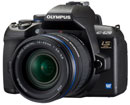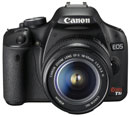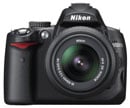Sony Alpha DSLR-A380
-
-
Written by Gordon Laing
Sony Alpha DSLR-A380 verdict
Sony’s Alpha A380 is the top model in the company’s consumer DSLR range, featuring 14.2 Megapixel resolution, built-in image stabilisation which works with any lens you attach, a quick Live View system and vertically-tilting screen. It’s a solid specification, although one which shares a great deal with its predecessor, the Alpha A350 – indeed as we mentioned at the start of this review, the internal specification is almost identical, with most of the changes being external.
This is an interesting strategy since the majority of new rival DSLRs look pretty similar to their predecessors on the outside but normally feature significant internal enhancements. Always fond of bucking the trend, Sony has opted for the opposite strategy here, keeping most of the internals of the A380 unchanged from the earlier A350, but housing them in a significantly redesigned body with a revamped user interface.
Sony has done this in an attempt to appeal to those buying their first DSLR, who have previously been put off by large cameras and tricky controls. Clearly convinced it had the internal specification right on its previous generation, Sony’s instead concentrated on shrinking the body and making it easier to use here – and it both respects it’s succeeded.
The Alpha A380 is indeed a little smaller than its predecessor and comfortably lighter too when both are fitted with their respective batteries. The user interface is also much friendlier than before, with help at every turn and icons representing how changes in the aperture and shutter speed will affect depth of field and motion.
As for the internal specification, most of what we said about the earlier A350 applies here: the 14.2 Megapixel sensor is capable of delivering detailed images under the right conditions, the built-in stabilisation provides around three stops of compensation against camera-shake, while the secondary sensor used in the Live View system allows it to be quick and fuss-free. And before you think Sony’s resisted the temptation to keep all the electronics the same, the A380 does now feature an HDMI port and a switch from Compact Flash to SD and Memory Stick Pro Duo media.
So far so good, but the A380 is not without its downsides. First let’s look at the new stuff, starting with the redesigned body. It’s certainly smaller and lighter than the earlier A350, but it remains larger and heavier than key rivals including Canon’s EOS 500D / T1i. Sony could argue this is due to its built-in stabilisation and tilting screen, but the Olympus E-620 has both of these (and a more flexible screen), while coming in smaller and lighter still.
Of greater concern, much of the A380’s weight loss is thanks to a less powerful battery which in turn has reduced the number of shots per charge – and there’s no optional battery grip either. Physical design is always a personal thing, but we’re not fond of the redesigned body which looks and feels more plasticky than many rivals, while employing an uncomfortable sawn-off grip. Of course it may feel great in your hands, and as always we’d recommend picking it up in person, but it just didn’t feel right to us.
Sticking with the new specs a little longer, the HDMI port is a welcome addition, but it’s come at the cost of a standard composite TV output, which means owners of older TV sets without HDMI connectivity won’t be able to play slideshows. We’re all for looking to the future, but this seems a daft omission. And while it’s not surprising to find a Memory Stick Pro Duo slot next to the new SD slot, Sony could have earned brownie points and boosted sales of its own format by allowing the camera to record to both cards simultaneously for backup, or to automatically switch when one’s full.
There’s also a new kit lens, with a slightly shorter 18-55mm focal range than before, but a new Smooth Autofocus Motor, or SAM for short. Anyone hoping this will be quick and quiet though will be disappointed to find it focusing at roughly the same speed and volume as rival 18-55mm kit lenses.
As for the parts inherited from the earlier A350, the sensor still suffers from more visible noise artefacts than rivals at higher sensitivities, and continues to deliver fairly soft output using the default settings. Continuous shooting remains very slow, delivering just under 2fps in our tests, ruling it out for serious action photography.
On the upside though, the Live View system, which uniquely employs a secondary sensor in the viewfinder head, remains refreshingly quick and fuss-free, and all the more useful with the tilting screen. But as discussed in detail in our Design page, there’s both pros and cons to this approach. Yes it’s quick and avoids complications while also using the main AF system, but by not using the main sensor, you don’t enjoy anywhere near 100% coverage or magnified focus assistance. It also compromises the size of the optical viewfinder, so as before, you’ll need to have a think about which Live View system best matches your style of photography.
It should also be noted that by sharing essentially the same electronics as its predecessor, the A380 also misses out on any kind of video recording facilities. Video may not be important to DSLR traditionalists, but it’s a key feature which many new buyers look for, and one that’s glaringly absent compared to two of its major rivals from Canon and Nikon. So before our final verdict, how does the Alpha A380 measure-up against the competition?
Compared to Canon EOS 500D / Rebel T1i
Canon’s EOS 500D / Rebel T1i is one of the major rivals for the Sony Alpha A380 with both cameras costing roughly the same with their kit lenses. There’s quite a few differences to weigh-up though. In its favour, the A380 features built-in stabilisation which works with any lens you attach. It employs a quicker and fuss-free Live View system and while its screen is smaller and less detailed, it’s mounted on a vertically-tilting platform for greater compositional flexibility. The help system and user interface are also more suitable for beginners. In its favour, the Canon has an extra Megapixel (although this doesn’t make much difference in real-life, especially with the kit lenses), a larger and more detailed 3in / 920k screen (albeit fixed in position), HD video recording at 720p / 30fps or 1080p / 20fps, four times the maximum sensitivity (12,600 ISO vs 3200 ISO), quicker continuous shooting (3.2 vs 2fps in our tests), a larger optical viewfinder, an optional battery grip, standard TV output in addition to HDMI, and a technically more accurate Live View system. Like all Canon DSLRs, you also get free PC / Mac based remote control software, and in our view, the ergonomics are also superior to the redesigned Sony body. The A380’s more approachable user interface and Live View system will see it appeal more to beginners, but enthusiasts or those who really want video will almost certainly get more out of the Canon. See our Canon EOS 500D / Rebel T1i review for more details. |
Compared to Nikon D5000
Nikon’s D5000 is another major rival for the Sony A380, and again pricing is similar for the basic kits. This time there’s slightly more in common, with both cameras sharing 2.7in / 230k screens which are mounted on articulated platforms and similarly-sized optical viewfinders. Both cameras also feature HDMI ports and lots of help for beginners. Beyond here though there are many differences to weigh up. In its favour, the A380 again features built-in stabilisation which works with any lens you attach, along with a quicker and fuss-free Live View system. There’s also two extra Megapixels over the Nikon, although in our tests this made little difference to real-life detail. In its favour, the Nikon D5000 has HD video capabilities at 720p / 24fps, much quicker continuous shooting (4fps vs 2fps in our tests), a screen which articulates in two axes rather than one, double the maximum sensitivity (6400 vs 3200 ISO) with much better quality at higher settings, a slightly more sophisticated AF system (11-point versus 9-point), on-demand grid lines in the optical viewfinder, a technically more accurate Live View system, a standard TV output in addition to HDMI, and in our view, much better ergonomics.  This time, the only real benefit to the A380 over the D5000 is its built-in image stabilisation which works with any lens you attach, although some beginners may prefer Sony’s user interface. Ultimately though, the Nikon D5000 is a highly compelling rival which combines high performance with excellent image quality. See our Nikon D5000 review for full details. |
Compared to Olympus E-620A third key rival for the A380 is the Olympus E-620, with both cameras sharing several things in common, including built-in image stabilisation which works with any lens you attach along with 2.7in / 230k articulated screens. Both also have the same 3200 ISO maximum sensitivity and neither offer video recording, but there are still a number of important differences to weigh-up. In its favour, the A380 features a quicker and fuss-free Live View system, a slightly more sophisticated AF system (9-point vs 7-point), along with an HDMI port and a user interface that’s more suitable for beginners. It also boasts two additional Megapixels, although again you won’t notice much difference in real-life. In its favour, the E-620 features a screen that’s fully-articulated (rather than just vertically tilting), faster continuous shooting (3.2 vs 2fps in our tests), a technically more accurate Live View system, series of in-camera special effects and both an optional battery grip and underwater housing. The E-620 is additionally smaller and lighter, while in our view also sporting superior ergonomics. Crucially it’s comfortably cheaper too. Since both cameras share the same key specifications of built-in stabilisation and articulated screens, much of the choice boils down to preferences between design and user interface. The Sony is certainly friendlier for beginners, but the E-620 delivers a powerful alternative that’s smaller and cheaper. See our Olympus E-620 review for more details. |
Also consider
The closest model to the A380 is of course Sony’s own A330. Both models are absolutely identical, other than their sensor resolution: 10.2 Megapixels on the A330 versus 14.2 Megapixels on the A380.
We’ll be testing the A330 in the near future, although since it also shares the same sensor as its predecessor, we expect the image quality to again be very similar. As such, the A330 could again find itself in the sweet-spot of the revamped A3xx range, offering the same fuss-free Live View and tilting screen as the top-end A380, but at a comfortably cheaper price thanks to its lower resolution sensor, with minimal actual differences in real-life detail with the kit lenses.
Sony Alpha DSLR-A380 final verdict
When Sony announced the Alpha A380 (and its lower-end counterparts the A330 and A230), it wasn’t hard to understand why many enthusiasts were disappointed. Most have become accustomed to new cameras featuring more powerful specifications such as higher resolutions, quicker shooting and bigger, more detailed screens, not to mention the adoption of gadgetry like movie modes.
With the A380 though Sony completely avoided that route, instead opting to keep essentially the same electronics as the earlier A350, and simply house them in a redesigned body with a revamped user interface. Sure, there’s a switch from Compact Flash to SD / Memory Stick Duo and a new HDMI port, but in terms of major specifications, there’s little change.
As such the A380 is certainly not an upgrade for owners of the previous Alpha generation. Anyone with an A200, A300 or A350 looking for an upgrade would be better-served looking at the higher-end A700 or waiting for Sony’s much-rumoured ‘A5xx’ or ‘A8xx’ ranges. Enthusiasts who value the latest specifications and gadgets will also do better looking elsewhere, and as discussed above, there’s certainly several compelling rivals for the same, or even less money.
But that’s not to say the A380 is a failure. Sony’s done its homework and is squarely targeting its revamped A3xx range at DSLR beginners. In order to appeal to these buyers, it’s gone for a much less intimidating user interface and a distinctive body design, and while we weren’t personally fond of the latter, it certainly stands out among the competition.
The target audience are also unlikely to be overly concerned by the below average performance at high ISOs, relatively slow continuous shooting and technical limitations of the Live View system; indeed they’re much more likely to be bothered by the lack of video recording. But ultimately many will be won over by the easy user interface, fuss-free Live View experience and fairly unique styling. Brand-loyalty is also not to be underestimated, especially where Sony is concerned.
So while the A380 is a disappointment for enthusiasts, it can be recommended as a first DSLR for absolute beginners so long as they get on with the ergonomics and don’t need video. Like its predecessor though, you’ll need a decent lens to really exploit its high resolution, such as the Carl Zeiss 16-80mm. If you’re intending to stick with the kit lens, you should seriously consider the cheaper Alpha A330 which is identical other than its lower 10.2 Megapixel resolution – fit both bodies with their kit lenses and you’re unlikely to notice a great deal of difference in real-life.
|
Bad points | Scores (compared to 2009 budget DSLRs) |
 | ||
Build quality: Image quality: Handling: Specification: Value:
Overall: |
16 / 20 16 / 20 16 / 20 17 / 20 16 / 20
81% | |||





